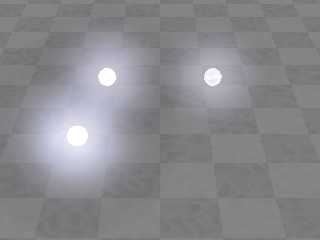|
 |
> First, you radius is defined as a function of your intensity, so of course they
> are linked.
Yes, I thought it might be beneficial if the glowing reaches farther in case of
brigther emitters...
> Second, define your density as a function
> density { function{Func(x,y,z)}
> rather than as spherical - that might help your fading
So I did that using exponential decay from the center and the result is much
better! The macro now reads:
#declare Exp_decay = function {
exp( -(pow(x,2) + pow(y,2) + pow(z,2))*80. )
};
#macro QuantumDot(Radius, Radius_aura, Intensity, Origin)
// The actual quantum dot
sphere{
<0,0,0>, Radius
texture{ Glass2 } // end of texture
translate Origin
} // end of sphere
// The glowing aura
sphere {
<0,0,0>,
Radius_aura*(1+Intensity)
pigment { rgbt 1 } hollow
interior
{ media
{ emission Intensity*5
density {
function { Exp_decay(x,y,z) }
color_map {
[0.0 rgbt <0,0,0,1>]
[0.5 rgbt <0.5, 0.5, 0.7,1>]
[1.0 rgbt <1,1,1,1>]
}
}
}
media
{ absorption 0.2
}
}
translate Origin
}
// #end // end of #for loop
#end // ------------------ end of macro
> The following is all speculation:
> I have some ambiguity about about the additivity of the emissivity.
> [say that 5 times fast]
I was laughing loudly though being alone in the room :D
> I think it might be your color map.
> You might have to use transmit as part of your rgb[t] designations to get a pure
> emission, use no light source, and turn on radiosity.
> might need to add a statement about absorption, but I don't know what the
> default behaviour is.
>
> Experts are online, waiting to answer your questions in the order you post...
See the attachment: the QDs alone are fine now, but The overlap is not. Setting
the transmittance to either 1 or 0 does not make any difference. I also set an
absorption as you mentioned.
BTW: how can I attach multiple files in one post?
Post a reply to this message
Attachments:
Download 'quantum_dot.png' (206 KB)
Preview of image 'quantum_dot.png'

|
 |




![]()